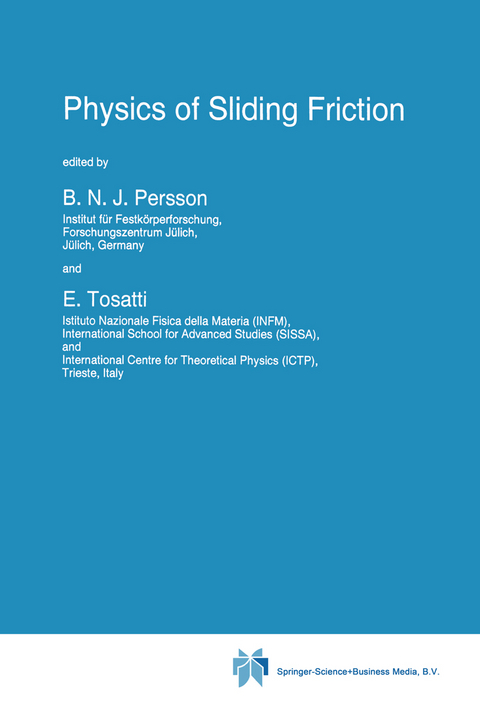
Physics of Sliding Friction
Springer (Verlag)
978-0-7923-3935-9 (ISBN)
The study of sliding friction is one of the oldest problems in physics, and certainly one of the most important from a practical point of view. Low-friction surfaces are in increasingly high demand for high-tech components such as computer storage systems, miniature motors, and aerospace devices. It has been estimated that about 5% of the gross national product in the developed countries is "wasted" on friction and the related wear. In spite of this, remarkable little is understood about the fundamental, microscopic processes responsible for friction and wear. The topic of interfacial sliding has experienced a major burst of in terest and activity since 1987, much of which has developed quite independently and spontaneously. This volume contains contributions from leading scientists on fundamental aspects of sliding friction. Some problems considered are: What is the origin of stick-and-slip motion? What is the origin of the rapid processes taking place within a lub at low sliding velocities? On a metallic surface, is the rication layer electronic or phononic friction the dominating energy dissipation pro cess? What is the role (if any) of self-organized criticality in sliding friction? How thick is the water layer during sliding on ice and snow? These and other questions raised in this book are of course only part ly answered: the topic of sliding friction is still in an early state of development.
1 Dry Friction Dynamics at Low Velocities.- 2 Dry Friction as a Hysteric Elastic Response.- 3 Experimental and Theoretical Investigations of Stick-Slip Friction Mechanisms.- 4 Sliding Friction of Lubricated Surfaces.- 5 What is Fluctuating in a Confined Liquid in the Stick-Slip Regime?.- 6 Sliding Friction in the Frenkel-Kontorova Model.- 7 The Solid-Like State of a Confined Liquid Lubricant: Deformation and Time Effects.- 8 Friction between Clean Surfaces and the Effects of Surface Randomness.- 9 On the Sliding Dynamics of the Frenkel-Kontorova Model.- 10 A Simple Model of Wearless Friction: The Frenkel-Kontorova-Tomlinson Model.- 11 Theory of Friction: Elastic Coherence Length and Earthquake Dynamics.- 12 Electronic Contributions to Sliding Friction.- 13 Probing the Electronic Friction via Surface Resistivity Measurements.- 14 Theory of Electron and Phonon Contributions to Sliding Friction.- 15 Low-Energy Vibrations of Molecular Species Adsorbed on Metal Surfaces.- 16 Electronic and Phononic Friction.- 17 The Surface Chemistry of Chlorinated Hydrocarbon Lubricant Additives.- 18 A Review of the Friction of Snow.- 19 The Sliding of Glaciers.- 20 Adhesion on the Nanometer Scale.- 21 Nano-Elastohydrodynamics. Structure, Dynamics and Flow in Nonuniform Lubricated Junctions.- 22 Friction Force Spectroscopy.- 23 Friction in the Low-Load Regime: Studies on the Pressure and Direction Dependence of Frictional Forces by Means of Friction Force Microscopy.- 24 Mechanism of Atomic Friction.- 25 Nanotribology at the Solid-Liquid Interface under Controlled Conditions.- 26 Is Self-Organized Criticality Possible in Dry Friction?.- 27 Periodic Solutions of Scaling Theory for the Burridge-Knopoff Model.
| Erscheint lt. Verlag | 29.2.1996 |
|---|---|
| Reihe/Serie | NATO Science Series E ; 311 |
| Zusatzinfo | XII, 460 p. |
| Verlagsort | Dordrecht |
| Sprache | englisch |
| Maße | 156 x 234 mm |
| Themenwelt | Naturwissenschaften ► Physik / Astronomie ► Mechanik |
| Technik ► Maschinenbau | |
| ISBN-10 | 0-7923-3935-5 / 0792339355 |
| ISBN-13 | 978-0-7923-3935-9 / 9780792339359 |
| Zustand | Neuware |
| Informationen gemäß Produktsicherheitsverordnung (GPSR) | |
| Haben Sie eine Frage zum Produkt? |
aus dem Bereich


